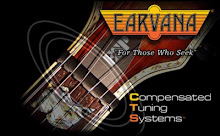EMG Pickups
"Our mission is to be the undisputed technological leader in the pickup industry, creating exceptional products that empower musicians around the globe to explore and express their passion for performance."

HistoryIn 1974, I started EMG in the back of my parents' garage by building various electronic gadgets and repairing amplifiers. I had played around with pickups as early as 1969 but didn't get around to "business" until a few years later.
We got our first business license under the name of Dirtywork Studios in April 1976. In 1978, we changed the name to Overlend, because we were overextended on credit and it sounded nice.
In 1983 we became EMG, Inc. (the big time) and haven't looked back. Through all the company name changes the pickups were always known as EMG Pickups. Not many people know why we called them "EMG", but we'll let you in on the secret now - EMG stands for Electro-Magnetic Generator!
WHY EMG PICK-UPS?Easy Installation - EMG's are easy to install. Each pickup features EMG's own Quik-Connect header and mating cable for quick installation. Included with each pickup are pre-wired volume and tone controls, battery clip, output jack, and diagrams. All models are designed for direct replacement into most standard instruments. There are instances where "direct" replacement isn't possible, but a minimum of work should be required.
Construction - There is no other pickup built as well as an EMG. The coils are precision wound, matched both resistively and inductively, and finally, vacuum sealed. All internal preamplifiers are Surface Mount Technology (SMT) for quality and reliability. Each pickup is tested for audio quality and reliability before encapsulation and again before shipment.
String Interface - The first choice in design is the string interface. The selection of a bar magnet or individual pole pieces is also an important one. All initial EMG designs use a bar magnet for two reasons - Pole pieces place too much magnetism under the strings and cause the lower ones (primarily low E, A, and D) to go "out of pitch" with a Doppler effect. This is especially true of the Fender Stratocaster* where 3 poles under each of the strings push and pull them through a variety of unnatural movements. Poles can also make intonation and tuning difficult. On the other hand, pole pieces have the benefit of a percussive attack giving the pickup much more of a "plucky" sound. Designs featuring a bar magnet have a much more linear (balanced) output from string to string. Its attack is less pronounced than the pole piece design resulting in smoother distortion, and much better sustain. String bending is smoother because the output doesn't fade when you bend strings. By relying on the internal preamp for gain the bar magnet can also be smaller, further limiting the magnetic "pull" on the strings. And, the continuous magnetic field of the bar allows for any string spacing. Perfect for any multi stringed instrument, and the less conventional instrument. Most EMG Pickups use a magnetic bar. Single coil pickups are available in both bar and pole-piece designs. There are fewer negative attributes to the bar and it's preferable, but if you like pole-pieces for your playing style then there is an EMG model for you.
 Magnets
Magnets - It's not really necessary for a pickup to have a magnet at all, but it helps. The magnet acts as the juice for the signal flow. The shape and type of magnet used in each EMG Pickup is different. Ceramic magnets don't affect the inductance of the coil but have a much stronger magnetic field. Alnico material exhibits less magnetism yet greatly increases the inductance of the EMG design. Each has an affect on the resultant output and frequency response of the pickup. The addition of steel poles (either bar or screw/stud) increase the inductance of the pickup design and further change the results.
Coils - Tall and skinny, short and squat, long and wide, every EMG Pickup has two and they are the basis of each EMG. There are different types and sizes of magnet wire that can be used, combining their attributes with the shape of the coil has a tremendous affect on the tone. A long, skinny coil will have more resistance yielding less low frequency response, while a short, squat coil will have less resistance, and more inductance. It's a balancing act to achieve the style of tone you want. In all cases, EMG Pickups have two coils. This is necessary for noise reduction, while providing the vehicle for the distinctive EMG tone. Coils are sometimes placed side by side, or stacked, but in both cases each coil is treated independently by the preamp. Instead of having the coils in series or parallel with a single output, they are electronically summed so their attributes can be controlled individually.
Internal Preamp - The preamplifier used inside each EMG Pickup is no ordinary preamp. Built directly into each pickup, the preamp is an integral part of the pickup design assuring quality of sound performance, incredible noise reduction, and simplicity in installation. It provides a variety of benefits for us as the designer and for you as the player. A natural by-product of the preamp is gain. It allows us to design a pickup for its particular tone without concern for the pickup's output. After the coils have been modeled, any amount of output needed is available from the preamp.

And many more Features:
Noise Reduction
Low Impedence Output
Power
Tone Modeling
There truly is no comparison between active EMG's and conventional pickups. EMG's frequency response is shaped much differently. Conventional pickups typically exhibit a dry "peaky" frequency response, while EMG's have a much broader bandwidth that's better for harmonic pull-offs and chord definition. Individual notes have better presence and are dynamic. Playing styles are more pronounced and different techniques can be easily accommodated.
The pickup designs used by the guitar companies are simply old technology. They are easy to design and inexpensive to produce, so there isn't any incentive to improve them. The problem for the player is that those pickups are as outmoded as black and white TV. Until you've experienced playing an EMG equipped instrument, you'll never know how great your playing can be. By using an integrated preamp it's possible to achieve better results than when designing with magnets and wire alone. The internal preamp in each EMG Pickup assures quality of performance, full noise reduction, simplicity of installation, and much greater output.
Professionals all over the world rely on EMG for their performance in the studio and on stage. EMG's are being used for every kind of music, from Rock & Roll to Jazz. Even the best Country artists choose EMG because they need a great performance each and every time.
Each EMG-HZ guitar pickup is created for its unique sound quality and includes features from over 25 years of EMG's design experience. Players all over the world agree that EMG is the leading authority in pickup technology. EMG-HZ: advancing the art of the passive pickup.
Please check out our line of EMG Pickups. GuitarPartsDepot.com is here for all your Guitar's needs!
 These guitar machines are a triumph in engineering and style. The housing provides a maximum bearing for worm gear and string post. Gear Ratio is 14:1. Worm and gear are precision-cut for perfect meshing. This eliminates backlash and slippage. Countersunk tension tension screw permits players to regulate turning tension to any degree. Gear box has a special lubricant for lifetime, trouble-free service. Includes 5/8' washers, bushings and wood screws.
These guitar machines are a triumph in engineering and style. The housing provides a maximum bearing for worm gear and string post. Gear Ratio is 14:1. Worm and gear are precision-cut for perfect meshing. This eliminates backlash and slippage. Countersunk tension tension screw permits players to regulate turning tension to any degree. Gear box has a special lubricant for lifetime, trouble-free service. Includes 5/8' washers, bushings and wood screws.

 Black Original Floyd Rose - With Fine Tuners
Black Original Floyd Rose - With Fine Tuners








 Magnets - It's not really necessary for a pickup to have a magnet at all, but it helps. The magnet acts as the juice for the signal flow. The shape and type of magnet used in each EMG Pickup is different. Ceramic magnets don't affect the inductance of the coil but have a much stronger magnetic field. Alnico material exhibits less magnetism yet greatly increases the inductance of the EMG design. Each has an affect on the resultant output and frequency response of the pickup. The addition of steel poles (either bar or screw/stud) increase the inductance of the pickup design and further change the results.
Magnets - It's not really necessary for a pickup to have a magnet at all, but it helps. The magnet acts as the juice for the signal flow. The shape and type of magnet used in each EMG Pickup is different. Ceramic magnets don't affect the inductance of the coil but have a much stronger magnetic field. Alnico material exhibits less magnetism yet greatly increases the inductance of the EMG design. Each has an affect on the resultant output and frequency response of the pickup. The addition of steel poles (either bar or screw/stud) increase the inductance of the pickup design and further change the results.









.gif)